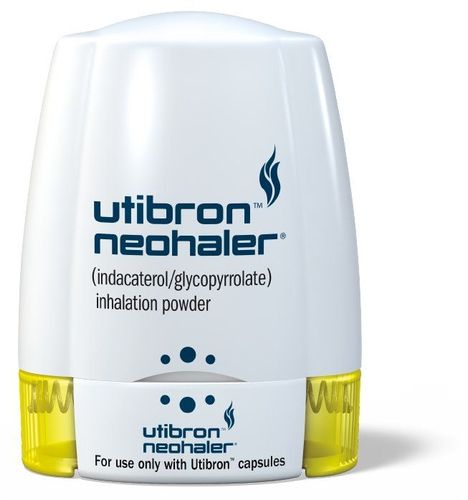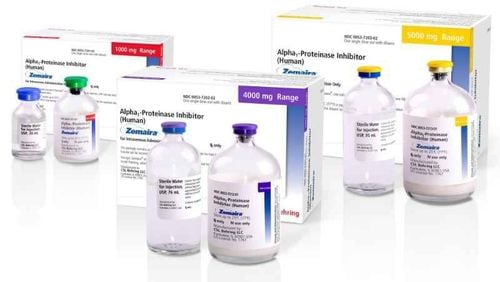This is an automatically translated article.
Spiriva Respimat drug is known quite popularly for the treatment of chronic bronchitis, shortness of breath, emphysema. So how to use Spiriva Respimat? What precautions should be taken when using this drug? Let's find out the necessary information about the drug Spiriva Respimat through the article below.
1. What is Spiriva Respimat?
Ingredients: Spiriva Respimat contains the main ingredient in each spray:
Tiotropium has a content of 2.5 mcg (one dose is equivalent to 2 sprays). Excipients are sufficient. Dosage form: aerosol solution.
Effects
The main ingredient of Spiriva is tiotropium, an anticholinergic active ingredient that relaxes bronchial smooth muscle in the airways.
Spiriva respimat is often indicated for the maintenance treatment of patients with COPD (chronic obstructive pulmonary disease) including: chronic bronchitis and emphysema; provide preventive treatment for dyspnea, improve quality of life for patients with COPD, and assist in reducing the occurrence of exacerbations.
Some other effects of the drug that are not listed on the approved drug label, but your doctor may prescribe you to take. You only use this medicine to treat certain medical conditions when prescribed by your doctor.
2. Uses of Spiriva Respimat
2.1 Indications Spiriva Respimat is indicated for use in the following cases:
Indicated for maintenance treatment of COPD patients (including chronic bronchitis and emphysema). Maintenance therapy for dyspnea. Improve the quality of life of COPD patients and reduce exacerbations. 2.2 How to use - Dosage of Spiriva Respimat How to use:
Drugs for inhalation.
Dosage:
The recommended dose of Spiriva Respimat is two sprays from the Respimat nebulizer once daily at the same time.
Do not exceed the recommended dose.
Special patient groups:
Elderly patients can take Spiriva Respimat at the recommended dose. Patients with renal impairment can take Spiriva Respimat at the recommended dose. However, as with all drugs that are eliminated primarily by the kidneys, Spiriva Respimat should be carefully monitored in patients with moderate to severe renal impairment. Patients with hepatic impairment can take Spiriva Respimat at the recommended dose. Children (under 18 years of age): COPD is uncommon in children, so the safety and effectiveness of Spiriva Respimat have not been established in pediatric patients. Note: The above dosage is for reference only. The specific dose depends on the condition and the progression of the disease. To get the right dose, you need to consult your doctor or healthcare professional.
2.3 Overdose, missed dose and management Overdose:
Due to low oral bioavailability, acute toxicity is unlikely to occur when unintentionally ingesting Tiotropium aerosol solution.
Missed dose:
Add dose as soon as you remember. However, if the interval between the next dose is too short, skip the missed dose and resume the dosing schedule. Do not take a double dose to make up for a missed dose.
3. Side effects of Spiriva Respimat
When using Spiriva Respimat, you may experience unwanted effects (ADRs). Common, ADR > 1/100:
Gastrointestinal: Dry mouth. Uncommon, 1/1000 < ADR < 1/100:
Neurological: Headache, dizziness. Respiratory: Cough, sore throat, hoarseness. Gastrointestinal: Constipation, oropharyngeal candidiasis. Skin and subcutaneous tissue: Itching, rash. Renal - urinary: urinary retention, difficulty urinating. Rarely, ADR < 1/1000:
Neurological: Insomnia. Eyes: Glaucoma, blurred vision, glaucoma. Cardiovascular: Atrial fibrillation, tachycardia, palpitations. Respiratory: Bronchospasm, laryngitis, epistaxis. Digestive: Difficulty swallowing, gastroesophageal reflux, tooth decay, stomatitis, glossitis, periodontitis. Skin and subcutaneous tissue: Angioedema, urticaria, dry skin, skin infections, skin ulcers. Renal - urinary: Urinary tract infection. Frequency unknown, ADR:
Metabolism: Dehydration. Respiratory: Sinusitis. Gastrointestinal: Nausea, intestinal obstruction, paralytic ileus. Skin and subcutaneous tissue: Anaphylactic reactions. Musculoskeletal: Joint swelling. Instructions on how to handle ADR When experiencing side effects of the drug, it is necessary to stop using it and notify the doctor or go to the nearest medical facility for timely treatment.
4. Notes when using Spiriva Respimat
Before using the drug you need to carefully read the instructions for use and refer to the information below.
Contraindications
Spiriva Respimat is contraindicated in the following cases:
Patients with known hypersensitivity to atropine or its derivatives, such as ipratropium or oxitropium, or to any of the excipients. Spiriva Respimat, as a once-daily maintenance bronchodilator, should not be used as initial therapy in acute bronchospasm as reliever therapy. . Immediate hypersensitivity reactions may occur following administration of Spiriva Respimat aerosol solution. As with other anticholinergics, Spiriva Respimat should be used with caution in patients with narrow-angle glaucoma, prostatic hypertrophy, or bladder neck obstruction. Inhaled drugs can cause inhaled bronchospasm. Spiriva should be used with caution and closely monitored in patients with moderate and severe renal impairment (creatinine clearance < 50 mL/min) due to increased plasma concentrations. Patients should be instructed to use Spiriva Respimat correctly. Take care to avoid getting solution or mist into eyes. Pain or discomfort in the eye, blurred vision, halos or colorful images with red eyes due to conjunctival congestion and corneal edema may be signs of acute narrow-angle glaucoma. Seek medical attention immediately if any combination of the above symptoms occurs. Eye drops that cause constriction are not an effective treatment. Dry mouth has been observed with cholinergic antagonist therapy, which may be persistent in association with caries. Spiriva Respimat should not be taken more than once per day. The Spiriva tube can only be used with the Respimat nebulizer. Ability to drive and use machines
No studies on the effects on the ability to drive and use machines have been performed. The appearance of dizziness or blurred vision may affect the ability to drive and use machines.
Pregnancy
There are no clinical data on the use of Spiriva in pregnant women.
Therefore, Spiriva Respimat should not be administered to pregnant or lactating women unless the expected benefit outweighs the possible risk to the fetus and infant.
Lactation
There are no clinical data on the use of Tiotropium in lactating women.
Therefore, Spiriva Respimat should not be administered to pregnant or lactating women unless the expected benefit outweighs the possible risk to the fetus and infant.
5. Drug interactions
Although no formal drug interaction studies have been conducted, Tiotropium bromide has been co-administered with other common COPD medications, including sympathomimetic bronchodilators, methylxanthine, oral and inhaled steroids, without being observed. clinical evidence of drug interactions.
Commonly used combinations (LABAs, ICSs and their combinations) used in COPD patients have not been found to alter tiotropium levels.
Long-term combined use of Tiotropium bromide with anticholinergics has not been studied. Therefore, Spiriva Respimat should not be used in combination with other anticholinergics for a long time.
6. Preservation
Temperature does not exceed 30 °C, do not freeze. Spiriva Respimat Nebulizer Care: Wipe down the mouthpiece including the metal inside of the mouthpiece with a damp cloth or paper towel at least once a week. The functionality of the Spiriva Respimat nebulizer is not affected by any minor discoloration on the mouthpiece. The outside of the Spiriva Respimat nebulizer can be cleaned with a damp cloth if necessary.
Please dial HOTLINE for more information or register for an appointment HERE. Download MyVinmec app to make appointments faster and to manage your bookings easily.













